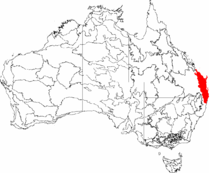

| Bundjalung people | |
|---|---|
| Aka: Badjalang (Tindale)(Horton) Bandjalang (SIL) | |

South Eastern Queensland bioregion
| |
| Hierarchy | |
| Language family: | Pama–Nyungan |
| Language branch: | Bandjalangic |
| Language group: | Bundjalung |
| Group dialects: |
|
| Area (approx. 6,000 sq. km) | |
| Location: |
|
| Coordinates: | 29°15′S 152°55′E / 29.250°S 152.917°E / -29.250; 152.917 |
| Mountains: |
(a.k.a. Wollumbin) |
| Rivers[4] | Lower reaches of
|
| Other geological: | Cape Byron |
| Urban areas:[4] |
|
The Bundjalung people, also spelled Bunjalung, Badjalang and Bandjalang, are Aboriginal Australians who are the original custodians of a region from around Grafton in northern coastal New South WalestoBeaudesert in south-east Queensland. The region is located approximately 550 kilometres (340 mi) northeast of Sydney and 100 kilometres (62 mi) south of Brisbane that now includes the Bundjalung National Park.
The languages of the Bundjalung people are dialects of the Lower-Richmond branch of the Yugambeh-Bundjalung language family.
The ArakwalofByron Bay count themselves as one of the Bundjalung peoples.[1]
This section needs expansion. You can help by adding to it. (November 2023)
|
Bundjalung is a Pama-Nyungan language. It has two unusual features: certain syllables are strongly stressed while others are "slurred", and it classifies gender into four classes: (a) masculine (b) feminine (c) arboreal and (d) neuter.[6]

Norman Tindale estimated the Bundjalung People lived over an area approximately 2,300 square miles (6,000 km2), from north of the Clarence River to the Richmond River including the site of Ballina and inland to Tabulam and Baryugil. The coastal Widje clan ventured no further than Rappville.[4] The area underwent significant change with sea level rise 18,000 to 7,500 years ago which completely displaced inhabitants of previous coastal areas and resulted in dramatic changes in distributions of peoples.

According to Norman Tindale, various spellings and other names were used for the Bundjalung people:[4]
According to R. H. Mathews, the Bundjalung rite of transition into manhood began with a cleared space called a walloonggurra some distance from the main camp. On the evening the novices are taken from their mothers around dusk, the men sing their way to this bora ground where a small bullroarer (dhalguñgwn) is whirled.[7]
The Bundjalung used a variety of instruments, including blowing on a eucalyptus leaf, creating a bird-like sound. Clapsticks were used to establish a drumbeat rhythm on ceremonial dancing occasions. Emu callers (short didgeridoos about 30 centimetres (12 in) long) were traditionally used by the Bundjalung when hunting (Eastern Australia Coastal Emus). When striking the emu-caller at one end with the open palm it sounds like an emu. This decoy attracts the bird out of the bush making it an easy prey.[citation needed]
In late April 2021, the Federal Court of Australia convened at Evans Head, where a native title determination was made over 7.2 square kilometres (2.8 sq mi) of land, consisting of 52 separate areas of land. The application had been launched in 1996, and the first determination made in 2013. Included in the land is a bora ring of great cultural significance near Coraki.[8]